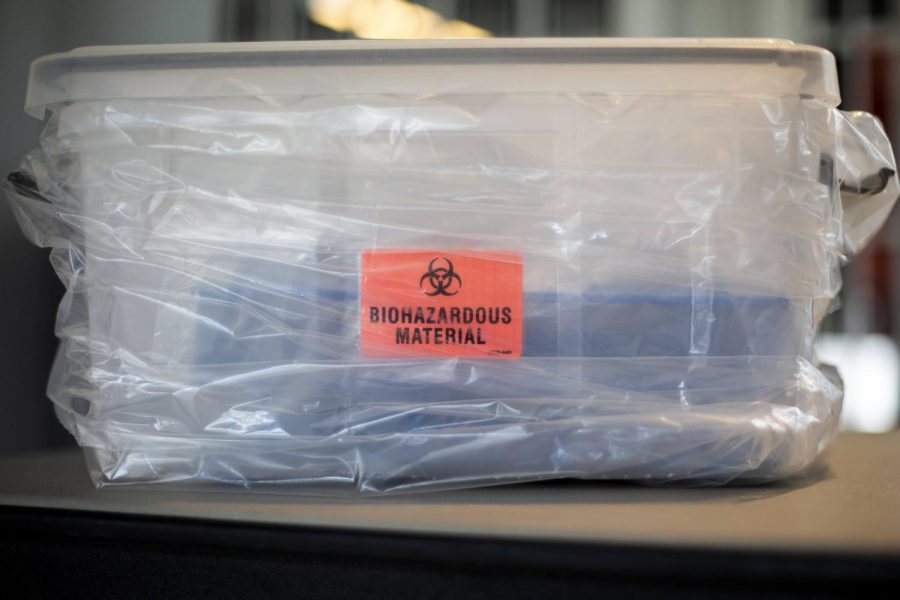Opinion | Online classes hinder student learning
A container filled with COVID-19 PCR test samples at the State Farm Center COVID-19 testing site on Oct. 9 2020. Columnist Micky Horstman believes that online classes negatively impact students learning.
Sep 7, 2022
Two years post the height of the COVID-19 outbreak, the University of Illinois fights a pandemic of its own making — online classes.
Since 2019, the University has seen a 91% increase in sections of online classes offered, while the number of in-person sections has decreased by 2%.
As stated in the University’s official FOIA response, “Due to the way the University tracks the numbers, the data provided reflects the number of sections, rather than courses. A single course may be offered in multiple sections, which may be at various times and locations — including online.” However, the startling increase in the number of online sections suggests online courses are here to stay.
In the fall of 2019, before a global pandemic curtailed the lives of college students nationwide, the University offered 703 online sections of courses. Today, they offer 1346. The number of in-person sections, while way up since COVID-19 was at its height, has decreased slightly compared to the 2019 numbers, despite admissions being at an all-time high.
For some, online classes offer a reprieve from the stresses of college learning. They provide a level of flexibility that in-person classes do not. If you have a busy semester, substituting an online section may be in your best interest.
Get The Daily Illini in your inbox!
But for many, the tiresome remote learning has grown old and the University’s continued culture of online learning post-COVID-19 has created a myriad of problems for students.
First, professors can scapegoat teaching. During the pandemic, professors abandoned synchronous Zoom lectures in favor of asynchronous pre-recorded lectures and discussion boards. For some classes, this pivot stayed after COVID-19. What used to be an in-person course is now done completely online.
Despite having virtual avenues for communication, coordinating group meetings for asynchronous classes is difficult. Without designated class time, there’s no guarantee scheduling will work and people will respond.
This style of asynchronous teaching hasn’t dispersed with the rest of the COVID-19 precautions, as some courses remain completely independent and students are left to fend largely for themselves. If these were all elective courses, that would be fine, but that isn’t the case as some of these courses are gen-eds and major-specific classes.
Brookings, a highly credited, nonpartisan think tank, summarized the research on how college students perform in online learning. Nearly every study points to a decrease in student performance, preparedness and participation. They found that students haven’t retained information taught from online prerequisites, are behind or are missing information entirely.
Last semester, the University was one of just four Big Ten schools to opt for a remote start in the spring, despite requiring masks and vaccinations to even step foot on campus. During the pandemic, the University did what it believed was best for public health and safety. The question is, even after realizing online learning is an inferior option, why hasn’t the University switched back to mostly in-person learning?
It’s worth noting the only “p” that hasn’t decreased is the price. Tuition and fee rates are determined by the number of credit hours a student takes and their residency status. They are not course-specific, which means an online course costs the same as an in-person class. This year marks the second consecutive increase in tuition since the COVID-19 pandemic, where most courses were taught online. Base tuition has increased by over $400 dollars for in-state residents and over $1000 for out-of-state residents.
Online learning doesn’t require building space or the traditional cost of in-person education. It saves the University money to offer remote courses because it defers the majority of external costs and responsibilities to students who use their own Wifi and computer.
Once a course has been produced online, it doesn’t cost the University any extra effort to keep it there. Maximizing online classes allows the University to enroll more students in self-governed courses, providing it with an avenue to nickel-and-dime students for an education subsidized with online courses.
There are real-world implications too. Students don’t have the same relationships with faculty and their peers as students who graduated before the pandemic. Socialization and networking are essential for professional success, but online learning stifles it.
Many professors still only offer virtual office hours, an added difficulty for students trying to build relationships in a completely remote classroom. This creates a problem when looking for recommendation letters for graduate school applications, attempting to find an advisor for a thesis or research project or seeking job advice.
Ask students if they would take an online course over an in-person class. They won’t.
Ask students at the University if they feel prepared to graduate. They don’t.
COVID-19 has become a part of our daily lives, and it’s not going away in the foreseeable future. But how long are students expected to be controlled by it? The University needs to refocus its efforts toward in-person learning and its students’ needs. Students need to be back in the classroom for their mental, social, and academic well-being. It’s time.
Micky is a senior in LAS.






